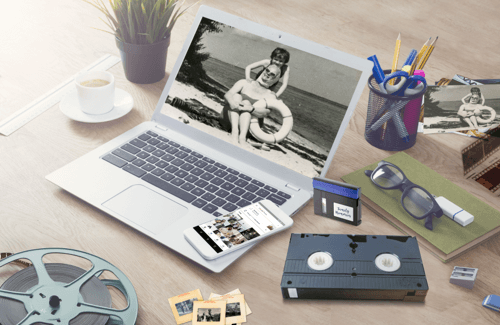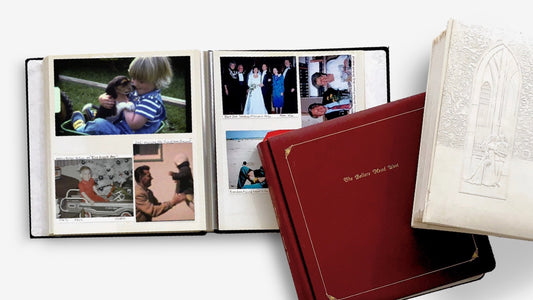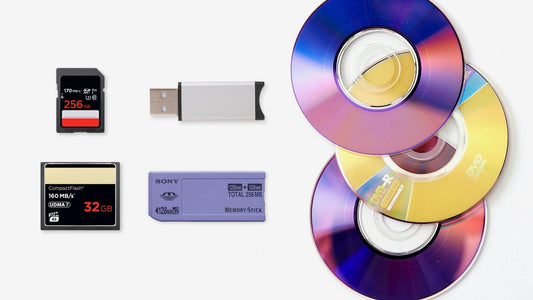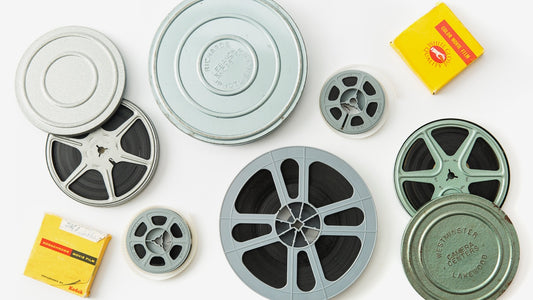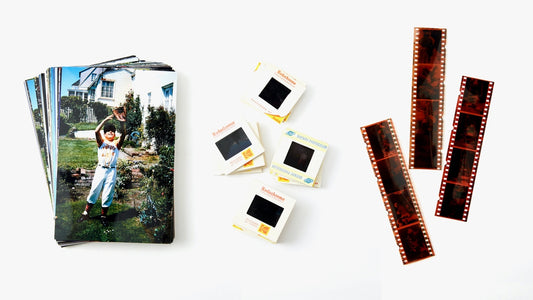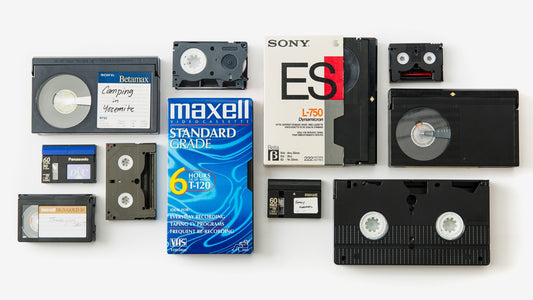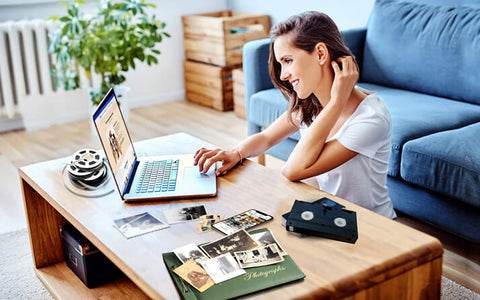That box of home movies in your closet holds more than just plastic cassettes—it holds moments. If you have a collection of small, compact DV tapes, you know they captured video with incredible digital clarity. But here's the problem: the tapes themselves are fragile and slowly deteriorating. The camcorders needed to play them are also disappearing fast. The window to save those birthdays, holidays, and family vacations is closing. The only way to protect them for good is to digitize your DV tapes, and this guide gives you the actionable steps to do it safely.
Key Takeaways
- Treat Tapes as a Temporary Medium: Although the video on DV tapes is digital, the physical tape itself is still susceptible to heat, humidity, and aging. The only way to permanently safeguard the footage is to transfer it to a modern digital file format.
- The Window to Play Your Tapes is Closing: The camcorders and decks needed to play DV tapes are obsolete and becoming more difficult to find in good working condition. Acting sooner rather than later ensures you can access your memories before the necessary hardware disappears completely.
- A Digital File Needs a Backup Plan: Once your videos are digitized, protect them by creating multiple copies. Store your files on at least two different types of media (like an external hard drive and a cloud service) to ensure they are safe from hardware failure or accidents.
So, What Exactly Are DV Tapes?
If you’ve ever stumbled upon a box of home movies from the late ’90s or early 2000s, you might have found a collection of DV tapes. Standing for "Digital Video," these tapes were a game-changer, acting as the bridge between bulky analog camcorders and the tapeless digital cameras we use today. They look like miniature cassette tapes but hold something much more precious: high-quality digital recordings of your family’s memories.
The most common type you’ll likely find is the MiniDV, a compact format that made home video cameras smaller and more portable than ever before. Unlike their analog predecessors (like VHS or Hi8), DV tapes captured video and audio as pure digital data. This leap in technology meant clearer pictures, crisper sound, and a more durable way to save your favorite moments. Understanding what these little tapes are is the first step in making sure those memories don't get left behind. If you have a collection of these tapes, a video transfer service can help bring those moments into the present day.
How Do DV Tapes Actually Work?
So, what made DV tapes so special? It all comes down to how they record information. Older analog tapes, like VHS, captured video as a continuous signal. Think of it like making a photocopy—every time you play or copy the tape, the quality gets a little bit worse. DV tapes, on the other hand, record video as digital data—a series of 1s and 0s. This means the video is a perfect digital copy of the original moment. When these tapes were introduced in 1995, this was a revolutionary step forward, offering families a way to capture memories with incredible clarity and precision that just wasn't possible before.
What Made Digital Tapes Better?
The biggest win for DV tapes is their incredible recording quality. Because they store video digitally, they don't suffer from the "generational loss" you see with analog formats. The video you recorded on day one will have the same sharp detail and vibrant color years later, provided the tape itself is in good condition. The audio is also significantly better. DV tapes capture uncompressed, CD-quality sound, so you can hear every laugh and conversation without the hiss and fuzz common on older tapes. This digital foundation means your memories were captured with a richness that makes them worth preserving.
Which DV Format Do You Have?
While there were a few different DV formats, the one you're most likely to have is the MiniDV. These compact tapes could typically hold between 60 and 90 minutes of high-quality video footage. An hour-long tape holds a surprising amount of data—around 14 gigabytes—which is why the video quality is so much better than older formats. When you're sorting through your collection, look for the "MiniDV" logo. Recognizing the format is the first step toward getting your tapes digitized, ensuring you can easily watch and share those irreplaceable family videos for years to come.
What Makes a High-Quality DV Tape?
When you pull out a box of old DV tapes, you might notice that some have held up better than others. The final quality of your home movies isn't just about the brand of the tape; it’s a mix of how it was recorded, its technical specifications, and its physical condition over the years. Unlike analog formats that degrade with every copy, DV tapes store video as pure digital data. This means that a well-preserved tape can look just as good today as the day it was filmed, with no generational loss. This is a huge advantage over formats like VHS, where every viewing and copy could introduce a little more fuzziness.
Understanding these factors can help you appreciate the memories stored on them and see why proper care is so important. From the recording mode you chose on your camcorder to how the tape has been stored in a closet for the last two decades, several key elements play a role in the clarity of the picture and sound you see and hear today. Getting the best possible playback depends on the tape's original recording quality and its current physical state. Let’s look at what really makes a difference in the quality of your DV tapes and why preserving them digitally is the best way to keep those memories safe.
How Much Can You Record on One Tape?
One of the first things you might remember about DV tapes is that you couldn't record for hours on end like you could with a VHS tape. A standard MiniDV tape typically held about 60 minutes of footage. This was because digital video contains a massive amount of data, and the tape had to be high-quality to store it all reliably. While this meant swapping tapes more often during a birthday party or vacation, it also ensured the video quality was much higher. The trade-off was simple: less recording time for a significantly better picture.
What's the Deal with Video Resolution?
The biggest leap forward with DV tapes was the resolution. Your DV camcorder captured video in a standard-definition digital format, typically at a resolution of 720x480. Because the video was recorded as pure data rather than an analog signal, the picture was incredibly sharp and clear for its time, free of the fuzziness common with older formats. This digital information doesn't degrade when copied, which is why digitizing your tapes is the perfect way to create a flawless, lasting archive of your original footage. The quality you see from the tape is the quality you'll get in your digital file.
What About the Sound Quality?
It wasn’t just the picture that improved; the sound quality on DV tapes was a game-changer, too. DV tapes recorded uncompressed, CD-quality audio (16-bit, 48 kHz). This means the audio is rich, clear, and true to life, capturing every laugh, conversation, and background sound without the hiss or warble of analog tapes. When you rewatch your videos, you’ll notice that the sound is just as crisp as the image, which makes reliving those moments feel much more immediate and real. This high-quality audio is another key reason to preserve your tapes.
Is Your Tape Damaged? Here's How to Tell
Even though DV tapes are digital, they are still physical media and can suffer from wear and tear. The tape itself is incredibly thin and fragile. Over time, you might encounter issues like dropouts (small, blocky glitches in the video) caused by tiny particles of dust or damage to the tape’s surface. The tape’s plastic shell can also become brittle and crack. More importantly, the tape must be able to survive the playback and winding process inside a camcorder. A damaged or degraded tape can easily get tangled or snap, which is why handling them with care and considering professional digitization is often the safest route for irreplaceable memories.
How to Keep Your DV Tapes Safe
Even though DV tapes record video digitally, they are still physical objects that can wear out, stretch, or get damaged over time. The magnetic tape inside is fragile, and protecting it is key to saving the memories stored on it. Think of proper storage and handling as the first line of defense against losing those irreplaceable moments. Taking a few simple precautions can make a huge difference in how well your tapes hold up until you’re ready to digitize them. The ultimate goal is to preserve the tape long enough for a successful transfer, ensuring your memories are safe for the future.
Where's the Best Place to Store Your Tapes?
Where you keep your tapes matters more than you might think. The ideal spot is cool, dry, and dark, with a stable temperature. Attics, basements, and garages are the worst offenders because they often have extreme temperature swings and high humidity, which can lead to mold and tape degradation. Instead, opt for a closet in the main part of your house. Store the tapes upright in their original plastic cases, like books on a shelf. This helps prevent the tape edges from getting damaged and keeps dust and debris out. A little care in choosing a storage spot goes a long way.
How to Handle Tapes Without Damaging Them
When you’re ready to watch or digitize your tapes, handle them with care. Always hold them by the outer cassette shell and avoid touching the tape itself, as oils from your skin can cause damage. Before you put a tape in a camcorder or player, make sure the equipment is clean and in good working order. Old, dusty players can easily chew up a delicate tape, destroying it in seconds. If you’re unsure about the condition of your old camcorder, the safest option is to use a professional video transfer service to avoid any risks.
What Does a Damaged Tape Look Like?
Give your tapes a quick visual inspection before you try to play them. Look for obvious signs of trouble like a cracked or broken cassette shell, visible mold or mildew (which can look like white or gray dust), or a wrinkled, stretched tape. During playback, watch out for red flags like a snowy picture, audio that cuts in and out, or glitchy, distorted video. These are all signs that the magnetic tape is deteriorating. Even if a tape looks fine on the outside, the data stored on it can degrade over time, so playback issues are a clear signal to get it digitized immediately.
Easy Ways to Stop Your Tapes from Fading
The single best way to prevent deterioration is to convert your tapes to digital files. Physical media will always degrade, but a digital copy can be backed up and preserved forever. While you’re waiting to digitize, you can slow down the aging process. Keep your tapes fully rewound to ensure the tape tension is even, which helps prevent stretching. Store them away from direct sunlight, moisture, and strong magnetic fields (like speakers or TVs), as these can erase the data. These steps will help keep your tapes in the best possible shape for a high-quality film transfer.
What Equipment Do You Need to Digitize DV Tapes?
If you're ready to digitize your DV tapes yourself, you'll need to gather a few key pieces of equipment. The process involves playing the tape on a compatible device and capturing the video feed on your computer. It might sound a little technical, but getting the right setup is the most important step toward saving your memories. The main components you'll need are a working DV player (like a camcorder), the right cables to connect it to your computer, and software to record the digital video file.
Finding all this gear can be a bit of a treasure hunt, since most of it is no longer in production. The biggest challenge is often sourcing a reliable player that won't damage your precious tapes. Once you have the hardware, you’ll need to make sure your computer can communicate with it, which sometimes requires special adapters for modern laptops and desktops. If sourcing and setting up the equipment sounds like too much of a hassle, remember that a professional video transfer service handles all the technical work for you. But if you're up for the project, let's break down exactly what you'll need.
Your Hardware Checklist
First things first, you need a device that can play your DV tapes. For most people, this will be the original Mini DV camcorder the videos were filmed on. If you don't have it anymore, you'll need to find a working DV camcorder or a dedicated DV tape deck. This piece of hardware is non-negotiable, as it's the only way to read the information stored on the tapes. A compatible camcorder is essential for transferring your tapes into a digital format. Make sure the player is clean and in good working condition before you insert a tape you care about, as a faulty player can easily damage old tapes.
Alternative Hardware Options
If tracking down a working camcorder feels like a lost cause, don't worry—you have other options. For Mac users, an older MacBook Pro running an operating system like macOS Mavericks can work well with software like Final Cut Pro 7. If you'd rather avoid Mac adapter headaches, a budget-friendly Windows desktop with an inexpensive Firewire card can get the job done. Another simple solution is a DV-to-USB converter, which lets you connect a player directly to your computer without needing a Firewire port. Of course, if sourcing old hardware and troubleshooting connections sounds like more trouble than it's worth, a professional video transfer service is the most straightforward path to preserving your memories safely and without any technical stress.
Which Software Should You Use?
Once you have a player, you'll need capture software on your computer. This program is what actually records the video feed from your camcorder and saves it as a digital file. There are many options out there, from free software that comes with your computer's operating system to more advanced video editing suites. The best choice really depends on your technical comfort level and the final quality you're aiming for. As one Reddit user points out, the way you digitize your tapes will influence the outcome, so pick software that feels approachable and meets your needs.
Software for Mac Users
If you’re a Mac user, you might find that digitizing DV tapes on a newer computer can be tricky. Modern versions of macOS have removed some of the older technology that made these transfers seamless, so software like Adobe Premiere Pro often struggles to connect with and control the camcorder. You might not even see a video signal. One workaround is to use Apple’s built-in QuickTime Player to record the video as it plays. However, this requires a chain of adapters to connect the FireWire cable from your camera to a modern Thunderbolt port, and these adapters can be expensive and sometimes unreliable.
Interestingly, the most straightforward DIY solution for Mac users is to go back in time. An older MacBook Pro running an operating system like macOS Mavericks, paired with an older version of Final Cut Pro (like FCP7), often works perfectly. This setup recognizes the camera and allows you to capture your tapes without the compatibility headaches of modern systems. If hunting down vintage hardware and software sounds like a project you’d rather skip, this is where a professional digitization service can save you a lot of time and frustration.
Software for Windows Users
For those on a Windows PC, the process is often much simpler and more affordable. You can equip a desktop computer with a FireWire card for less than $20, giving you a direct connection to your DV camcorder. Once you’re connected, you have several great software options. A popular free choice is WinFF, which can easily capture your footage. Another powerful and free tool is OBS (Open Broadcaster Software), though you may need an RCA-to-USB converter if you aren't using a FireWire connection.
If you’re more technically inclined, you could explore advanced tools like DaVinci Resolve, although its performance for DV capture can be inconsistent. For the truly tech-savvy, a command-line tool called ffmpeg offers complete control, allowing you to copy the raw video data directly from the tape. With a Windows machine, you have a clear and cost-effective path to digitizing your tapes yourself, with plenty of free software available to get the job done right.
How to Connect Your Camcorder to Your Computer
This is where things can get a little tricky. Most DV camcorders use a specific port called IEEE 1394, which you might also see called FireWire or i.LINK. This connection was amazing because it allowed you to transfer video to a computer with zero loss in quality. The problem? Almost no modern computers have a FireWire port. This means you'll likely need a series of adapters to bridge the gap—for example, a FireWire to Thunderbolt adapter if you're using a Mac. Getting this connection right is crucial for a clean, high-quality transfer.
Where to Find a Working DV Player
So, where can you find a DV camcorder or deck if you don't have one anymore? This is often the biggest hurdle. Since these devices are no longer manufactured, you'll have to look on the second-hand market. Websites like eBay are a popular option, but you can also try local thrift stores, garage sales, or even asking friends and family. As users in online videography communities note, many people have boxes of old tapes and are also searching for players. Be prepared to test any device you find, as old electronics can be unreliable.
Considering a Refurbished Transfer Bundle
If the thought of searching online marketplaces for a working camcorder and the right cables feels overwhelming, you're not alone. A refurbished transfer bundle can be a great shortcut. These are essentially all-in-one kits designed specifically for digitizing old tapes. They typically include a tested, working MiniDV camcorder, all the necessary cables like FireWire and USB adapters, and the software needed to capture your video. This takes the guesswork out of finding compatible parts and ensures you have everything you need to get started in one box.
The main advantage is convenience. Instead of piecing together a setup from various sellers, you get a complete package that is meant to work together. While these bundles make the DIY route more accessible, it's still a hands-on project that requires your time and attention. If you prefer to skip the technical setup entirely, a professional video transfer service can handle everything for you, ensuring your tapes are digitized safely and with the highest quality, letting you get straight to enjoying the memories.
How to Digitize Your DV Tapes
Once you’ve gathered your tapes, you have two main paths for converting them to digital: doing it yourself or using a professional service. The right choice depends on your comfort with technology, the time you have, and the condition of your tapes. If you have the right equipment and a bit of patience, the DIY route can be a rewarding project. However, if your tapes are precious or you’re short on time, a professional service offers peace of mind and expert handling. Let’s walk through what each option involves so you can decide what’s best for your family’s memories.
Going DIY: A Step-by-Step Guide
To digitize your DV tapes yourself, you’ll need a few key pieces of equipment. The most important is a working DV camcorder or deck that can play your tapes. It’s crucial to ensure that your camcorder is in good condition so you can play the video smoothly without damaging the tape. You’ll also need a special cable (like a FireWire cable) and potentially an adapter to connect the camcorder to your computer. From there, you’ll use video capture software to record the footage in real-time as it plays. This process can be time-consuming, as you have to play each tape from start to finish, but it gives you complete control over the project.
Why You Should Use the Original Camera
If you still have the camcorder you used to film your home movies, you’re in a great position. Using the original camera is almost always the best way to digitize your DV tapes. Think of it like this: every camcorder records video onto a tape in its own unique way, almost like handwriting. The original camera is perfectly suited to read its own "handwriting." When you play a tape on a different device, it might struggle to interpret those subtle differences, which can lead to glitches, distorted video, or audio dropouts. Sticking with the original camera helps you avoid potential playback issues and ensures the digital copy is as clear and true to the original moment as possible.
When to Let the Pros Handle It
If the DIY method sounds too technical or you can’t find a working camcorder, a professional service is an excellent alternative. Companies like YesVideo specialize in this process, using patented methods to safely transfer your irreplaceable media to digital formats. Our video transfer service converts all kinds of videotape formats, including Mini-DV, into digital files you can easily watch and share. By handing your tapes over to experts, you can feel confident that your memories are being handled with care in the USA and that you’ll receive high-quality digital files without any of the hassle.
How Mail-In Digitization Services Work
Using a mail-in service is straightforward and designed to be as simple as possible. You have two main ways to turn your MiniDV tapes into digital files: do it yourself, or send them to a professional. With a service like YesVideo, you start by placing an order and receiving a kit with a pre-paid shipping label. You just pack your tapes securely in the box, send them off, and the experts take it from there. Your tapes are carefully handled, digitized using professional-grade equipment, and then safely returned to you along with your new digital copies. It’s the perfect option if you want to ensure a high-quality transfer without the stress of finding and setting up old equipment.
Advanced Options to Improve Video Quality
One of the biggest advantages of using a professional service is the ability to improve the original footage. While DV tapes have excellent quality, time can still take a toll. Many services offer post-processing enhancements to make your videos look their best. This can include color correction to restore faded or shifted colors, contrast adjustments to make the picture pop, and digital noise reduction to clean up any fuzzy or grainy parts of the video. These small tweaks can make a huge difference, resulting in a final digital file that looks sharper and more vibrant than the original tape, breathing new life into your cherished memories.
Understanding Professional Service Costs
When you use a professional service, the cost is typically calculated on a per-tape basis. This makes it easy to estimate the total price based on the size of your collection. Many companies also offer volume discounts, meaning the more tapes you send in to be digitized, the lower the cost per tape becomes. This is a great incentive to gather all your family’s home movies—from DV tapes to VHS and Film Reels—and get them all converted at once. It’s a worthwhile investment to protect your entire library of memories, and bundling them together can often make the process more affordable.
How You’ll Receive Your Digital Files
Once your tapes are digitized, you’ll have several options for receiving your new files. Most services offer a choice between physical media and digital access. You can have your videos saved as MP4 files on a USB drive, which is a great way to have a physical backup that you can plug into any modern computer or smart TV. Another popular option is a direct download link from the cloud, giving you instant access to your files so you can easily save them to your computer and share them with family and friends. For those who still prefer it, DVDs are often available as well, giving you a familiar format to watch on a standard DVD player.
How to Check Your Transfer Quality
Whether you digitize the tapes yourself or use a service, it’s important to check the final quality. The first sign of a good transfer is that the original tape survived the process. As experts note, regardless of fancy features, the tape must survive the playback and winding process. Once you have the digital file, watch it through. Look for a clear, stable picture and listen for consistent audio that’s synced with the video. Check for any digital glitches, dropped frames, or blocky sections that weren't on the original tape. A quality transfer should be a faithful digital replica of your home movie.
Troubleshooting Common Transfer Problems
Even with the right equipment, the DIY digitization process can sometimes hit a snag. Old tapes and aging hardware can be unpredictable, leading to frustrating errors that interrupt your transfer. Don't get discouraged if your first attempt isn't perfect. Many common issues, from glitchy video to software that just won't cooperate, have straightforward solutions. Understanding what's going wrong is the first step to fixing it and getting a clean, complete digital copy of your home movies. Let's look at one of the most frequent problems you might encounter and what you can do about it.
Dealing with Timecode Dropout
One of the most common frustrations when digitizing DV tapes is something called "timecode dropout." Essentially, the tape has an internal clock that tells the computer where it is in the video. When parts of the tape are damaged or degraded, that clock gets messed up, and your capture software might stop recording or split your video into dozens of tiny, separate clips. This happens because even though the video is digital, the tape itself is a physical medium. As mentioned in a Reddit discussion about digitizing MiniDV tapes, these dropouts can cause major issues during import. It’s often a sign of wear and tear, where dust or physical damage to the tape's surface interrupts the data stream.
If you run into timecode dropouts, the first thing to check is your equipment. Sometimes, dirty playback heads on your camcorder are the culprit, so a good cleaning might solve the problem. However, if the issue persists, it’s likely a problem with the tape itself. This is where you need to be careful. A degraded tape can easily get tangled or snap inside a player, which could permanently destroy your footage. If the memories on the tape are irreplaceable, this is the point where it’s often safer to stop and consider professional help. A dedicated video transfer service has the specialized equipment and expertise to handle fragile tapes and recover footage safely, ensuring your memories aren't lost to a technical glitch.
What's the Best Digital Format for Your Videos?
When it comes to digital formats, you want something that is both high-quality and easy to use. If your main goal is simply viewing the videos on various devices, a common format like H.264 (usually in an MP4 file) is a fantastic choice. It offers a great balance of quality and file size, making it perfect for storing, sharing with family, or uploading to the cloud. For those diving into the technical side, some suggest you can capture to HDV and then transcode to H.264. When you use a service like YesVideo, we take the guesswork out of it by providing your memories in a user-friendly format that’s ready to enjoy.
How to Preserve Your Newly Digitized Memories
Congratulations, you’ve digitized your DV tapes! That’s a huge step toward protecting your family’s memories. But the work isn’t quite done. Think of your new digital files as the precious cargo you’ve just rescued. Now, you need a safe place to keep them. Even though DV tapes are digital, they can still wear out and get damaged over time, which is why you digitized them in the first place. Your new digital files need a preservation plan to ensure they don’t meet a similar fate due to a hard drive crash or a lost USB stick. Creating a solid storage and backup strategy is the final, crucial step to making sure those moments—from birthday parties to holiday gatherings—are safe, sound, and ready to be enjoyed for decades to come.
Choosing a File Format for the Future
The file format you choose for your digitized videos is like the foundation of a house—it needs to be strong and built to last. You want a format that’s easy to play on any device, whether it’s your computer, smart TV, or phone, without needing special software. For video, the most widely supported and high-quality option is H.264, usually saved in an MP4 file. This format gives you beautiful, clear video without creating enormous files that are difficult to store and share. When you use a professional video transfer service, you can be confident you’re getting your memories back in a format that’s perfect for both viewing today and preserving for tomorrow.
Don't Lose Your Files: Your Backup Strategy
If your memories only exist in one place, they aren’t truly safe. Hard drives fail, laptops get stolen, and accidents happen. That’s why having a reliable backup plan is non-negotiable. The gold standard in the data world is the 3-2-1 rule, and it’s simple to follow: keep at least three copies of your files, on two different types of storage media, with one copy stored off-site. For example, you could keep one copy on your computer’s internal hard drive, a second on an external hard drive, and a third in the cloud. This approach protects your precious videos from almost any disaster, from a simple hardware failure to a house fire.
Where to Store Your Digital Memories
Let’s break down your storage options from the 3-2-1 rule. For your local copies, an external hard drive is a great, affordable choice. You can easily plug it into your computer to watch videos or make copies for family. For your off-site copy, a cloud storage service is your best bet. Services like Google Photos, Dropbox, or Amazon Photos automatically sync your files and keep them safe on secure servers, so you can access them from anywhere. Many digitization services also offer their own cloud storage solutions, giving you immediate, secure access to your memories as soon as they’re transferred, which is a fantastic and convenient option.
How to Future-Proof Your Videos
Future-proofing your memories means making sure you can still press "play" in 10, 20, or even 50 years. The first step is choosing a universal file format like MP4, which we’ve already covered. The next step is maintenance. Set a calendar reminder to check on your files once a year. Open a few videos to make sure they still play correctly. It’s also a good idea to migrate your files to new storage devices every five to seven years. Technology changes, and the external hard drive you buy today won’t last forever. By periodically updating your storage, you ensure your digital media doesn’t get left behind on obsolete or failing hardware.
Common DV Tape Myths, Debunked
When it comes to preserving old home movies, a lot of misinformation can float around, especially for formats like DV tapes. Because they were the bridge between analog and fully digital files, they're often misunderstood. Let's clear up some of the most common myths so you can make the best decisions for your memories. Getting the facts straight is the first step toward ensuring your family’s moments are safe for generations to come.
Myth: "Digital Tapes Last Forever"
It’s easy to assume that because the data on DV tapes is digital, the tapes themselves are invincible. Unfortunately, that’s not the case. While the quality won't degrade with each playback like a VHS tape, the physical tape is still susceptible to the same environmental threats. Over time, the magnetic tape can stretch, get brittle, or fall victim to mold and humidity. Even though they are digital, Mini DV tapes can still wear out and get damaged. The only way to truly protect the footage on them is to transfer it to a modern digital file format that can be easily backed up and stored on a hard drive or in the cloud.
The 15-to-25-Year Lifespan of DV Tapes
This might come as a surprise, but your DV tapes have a shelf life. Research suggests they typically last between 15 and 25 years before the physical tape starts to break down. While the video itself is a perfect digital copy, the magnetic tape it's stored on is incredibly fragile. Over the years, this thin ribbon is prone to stretching, becoming brittle, or even developing mold if not stored in ideal conditions. This physical decay leads to irreversible damage, causing glitches, audio dropouts, or making the tape completely unplayable. The only way to truly stop this countdown is to transfer the footage to a modern digital file, creating a permanent, stable copy that isn't tied to an aging piece of plastic.
Myth: "Any Transfer Method is Fine"
You might be tempted to buy a cheap converter online and tackle your box of tapes over a weekend. While the DIY spirit is admirable, not all transfer methods produce the same results. At-home options often lead to low-quality video with compression issues, audio sync problems, or dropped frames. For the best possible quality, it’s worth trusting professional services that use high-end, properly maintained equipment. Experts can clean the tapes, make minor repairs, and capture your footage in a high-quality format, ensuring your memories look as good as you remember them.
Myth: "You Can Store Them Anywhere"
That box of DV tapes sitting in the attic or basement might seem safe, but extreme temperatures and humidity are a tape’s worst enemy. These conditions can accelerate the deterioration process, causing the tape to become brittle or develop mold, which can ruin it completely. Proper storage in a cool, dry, and dark place can certainly extend a tape's life, but it doesn't stop the clock forever. Physical media will always be at risk of degradation, no matter how carefully it's stored. Digitizing your tapes removes this risk entirely, giving you a permanent and much more durable copy of your home movies.
Myth: "Finding a Player is Easy"
Finding a working DV camcorder or deck today can be a real challenge. These devices haven't been manufactured in years, and the ones that still exist are often in poor condition. Many people have boxes of tapes with no way to play them back. Even if you manage to find a player on an auction site, there’s no guarantee it will work properly. An old, malfunctioning player could even chew up and destroy your irreplaceable tapes. Using a trusted service for your film transfer eliminates the hassle and risk of hunting down obsolete equipment.
Why You Should Digitize Your DV Tapes Now
You’ve safely stored your DV tapes for years, but what’s the long-term plan for the memories they hold? Technology moves fast, and the world of video has changed dramatically since the days of camcorders. Relying on old tapes means your precious moments are stuck on a format that’s fading away. It’s time to think about how you can bring those memories into the present and ensure they last for generations to come. The best way to do that is by understanding where the technology is headed and making a plan to future-proof your home movies.
Why the DV Format is Fading Away
Remember when DV tapes were the latest and greatest? They offered a huge leap in quality from the analog tapes that came before them. But by the 2010s, their time in the spotlight was already coming to an end. Newer cameras began using memory cards and solid-state drives, which were not only more convenient but also offered even higher quality recording. This shift left DV tapes, and the camcorders that play them, behind. Like floppy disks and VCRs, the DV format) has become a piece of video history, making it harder to access the memories stored on them.
The Shift to Digital Files
While Mini DV tapes were a fantastic step into the digital world, the technology has taken another giant leap forward. Today, digital files—like the MP4s you watch on your phone or computer—are the standard for a reason. They offer more storage, are incredibly easy to use, and provide excellent quality without the risk of physical decay. Unlike a tape that can get chewed up or degrade over time, a digital file can be copied and backed up without any loss of quality. This makes it simple to share that hilarious birthday party video with family across the country or create a highlight reel for a wedding anniversary.
Why It's So Hard to Find a Working Player
One of the biggest hurdles in watching your old DV tapes is finding a device that can actually play them. Many of us have boxes of old tapes but no longer own the original camcorder. Even major manufacturers like Sony have stopped producing new tapes, and finding a working player or camera on the secondhand market can be a frustrating and expensive treasure hunt. Many people in online videography communities are searching for these old decks just to transfer their footage. The window to easily access these memories is closing, as the hardware becomes scarcer every year.
Act Now to Save Your Home Movies
The single best way to protect your recordings for the future is to digitize them. This simply means converting the video from your tapes into modern digital files that you can store on a computer, in the cloud, or on a USB drive. By doing this, you free your memories from outdated hardware and make them accessible for years to come. A professional video transfer service handles all the technical work for you, using high-quality equipment to ensure your memories look their best. At YesVideo, we make it easy by providing a Digital Download with every order and options to add a USB or even save your memories directly to Google Photos.
Related Articles
Frequently Asked Questions
What makes DV tapes different from older formats like VHS? The biggest difference is how they record video. Older tapes like VHS are analog, meaning the quality gets a little worse every time you play or copy them. DV tapes, on the other hand, record video as pure digital data—a perfect snapshot of the original moment. This is why the picture is so much sharper and the sound is crystal clear, without the fuzz and hiss you might remember from your VCR days.
My tapes have been stored safely for years. Why is it so urgent to digitize them now? Even though the video data is digital, the tape itself is a fragile physical object. Over time, the thin magnetic tape can become brittle, stretch, or even grow mold, no matter how well it's stored. Plus, the camcorders and decks needed to play them are becoming harder to find and less reliable. Digitizing your tapes now protects your memories from physical decay and ensures you won't be stuck with tapes you have no way to watch.
I don't have my old camcorder anymore. What are my options for watching my tapes? This is a really common problem. Your main options are to either hunt for a working player on a secondhand market like eBay or to use a professional transfer service. Buying an old camcorder can be risky, as it might not work correctly and could even damage your tapes. A professional service is the safest route, as they use well-maintained, high-end equipment to carefully handle and convert your home movies.
Is it better to try and digitize my tapes myself or use a professional service? The right choice really depends on your comfort with technology and how much time you have. The do-it-yourself method requires finding a working camcorder, the correct cables and adapters for your computer, and learning how to use capture software. If that sounds like a hassle or you're worried about risking your irreplaceable tapes, a professional service handles all the technical work for you and delivers high-quality digital files with no stress.
Once my tapes are digitized, what's the simplest way to keep the new files safe forever? The best strategy is to have multiple copies in different places. A simple approach is to keep one copy on an external hard drive that you store at home and another copy with a cloud storage service. This protects your videos from everything from a computer crash to a house fire. Having a cloud backup also makes it incredibly easy to share your favorite family moments with anyone, anywhere.





